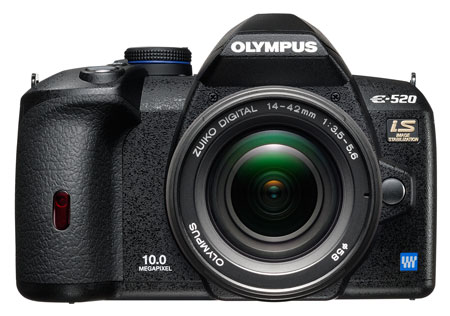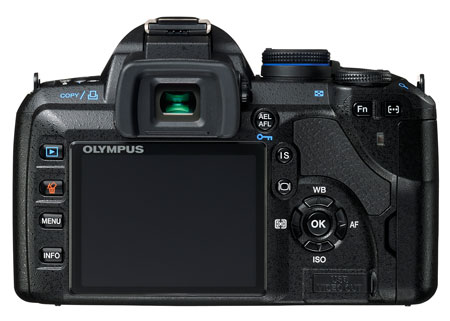Olympus E-520: Improved IS, Double Live View, and More
by Wesley Fink on May 14, 2008 12:10 AM EST- Posted in
- Digital Camera
Additional Features
The HyperCrystal™ II LCD display grows to 2.7 inches in the E-520, matching the new E-420. The Olympus trademark Supersonic Wave Filter auto-sensor cleaning system has appeared on every Olympus DSLR since the E-1 and it is continued on the new E-520. Sensor Resolution remains 10 megapixels but it is now derived from 11.8 million effective pixels. While the resolution is the same as the E-510 it appears the sensor for the E-520 and E-420 are upgraded from the earlier models. Other features include:
- In-Body Image Stabilization with Supersonic Wave Drive™ technology provides blur-free images when using any of the more than 30 digital-specific lenses;
- Face Detection Technology targets and locks on faces to ensure they are in focus and blur-free for amazing portraits;
- Shadow Adjustment Technology opens up detail in the shadows that other cameras would render too dark or underexposed while maintaining detail in the highlights; and
- Perfect Shot Preview enables photographers to view and select White Balance and Exposure Compensation effects right on the LCD, and see how the image will look before they even capture it.



Enhanced In-Body Image Stabilization
For the first time, in-body Mechanical Image Stabilization has three modes for increased
versatility. IS-1 mode for general shooting adjusts the sensor on both the X and
Y axes to compensate for movement by the photographer so images stay sharp even
at slow shutter speeds. To capture the motion of athletes and animals, and other
moving subjects, the E-520 offers two specialized modes. IS-2 mode is ideal for
capturing a racecar flying down the track, preserving the sense of motion while
panning with the moving subject and holding the camera horizontally to dramatically
portray the car’s high speed. For sharp images of moving subjects like a basketball
player charging up the court, the IS-3 mode allows a photographer to hold the camera
vertically while panning. The artistic effects of panning enhance the shot and render
the player in sharp detail with blurred background.
Always Find a Face in the Crowd
The E-520’s Face Detection reduces the chance of blurred subjects in photography
by distinguishing between people’s faces and the background. It tracks up to eight
faces within the image area even if people are moving and automatically focuses
and optimizes exposure for sharp, brilliant portrait pictures.
In Sunshine or the Shadows, Never Miss a Detail
Shooting scenes with shadows can be tricky because of the extreme contrast between
dark and bright areas. The E-520 addresses this challenge with Shadow Adjustment
Technology that compensates for extreme contrast and maintains visible detail in
both the shadow and highlight areas of the scene. Now users can preview and capture
images showing the shadow detail they saw. This feature is also available in the
Edit menu after the shot has been taken.
Preview a Multitude of Possibilities
Perfect Shot Preview enables users to preview and select from a variety of thumbnail
previews of the photographic effects of white balance and exposure compensation
adjustments live on the LCD before taking the photograph. It is an ideal way for
novice users to learn about the effects of different photography techniques, visually,
without having to scroll through menu options. With 20 preset scene-select modes
for every imaginable shooting scenario from underwater photography to fireworks,
and program, automatic modes and full manual controls, the E-520 offers a world
of possibilities to photographers.
Experience Life under the Sea
Olympus will offer the PT-E05 optional underwater housing for the E-520 to allow
photographers to document the richness of life in the depths. Capable of reaching
depths of 130 feet underwater, the housing will ensure that divers will not miss
an image during their journeys to the abyss. Special underwater scene modes on the
E-520 will assure that the camera is set up correctly for underwater use.
Wireless Flash Capability
Sometimes wireless flashes can help photographers cast the best light on their subjects
and capture great images. For this reason, the E-520 is compatible with the Olympus
FL-50R and FL-36R wireless electronic flashes that are designed exclusively for
digital photography. When these flashes are used in combination with the E-520,
wireless multi-flash photography is possible. The E-520 can control up to three
wireless flash groups independently, with multiple flash units in each group.
TruePic III for Image Clarity & Speed
The 10.1 megapixel E-520’s TruePic III Image Processor produces crystal-clear photos
using all of the pixel information for each image to provide the best digital images
possible for every photo with accurate color, true-to-life flesh tones, brilliant
blue skies and precise tonal representation in between. TruePic III also lowers
image noise by one step to reduce graininess in images shot at higher ISO settings,
enabling great results in low-light situations.
Availability
The Olympus E-520 Digital SLR will be available in July 2008. It includes: E-520
Body, USB Cable, Video Cable, Li-Ion Battery Pack (BLM-1), Li-Ion Battery Charger
(BCM-2), Shoulder Strap, OLYMPUS Master Software CD-ROM, Manuals and Warranty Card.
U.S. Pricing/Product Configurations
E-520 body Estimated Street Price: $599.99
E-520 with ED 14–42mm f3.5/5.6 Zuiko Digital Zoom Lens Estimated Street Price: $699.99










23 Comments
View All Comments
punchkin - Saturday, May 17, 2008 - link
... nobody edits these articles. The writer should enroll in the closest community college English program post-haste.allajunaki - Thursday, May 15, 2008 - link
Something I have been noticing, Most of the SLR's are now going Live View with Contrast detect AF. Just curious, Isnt that what Point and Shoot's been using all this while?I was under the impression that Phase detect is the fastest AF available and that Contrast detect by nature is very slow in focussing. Have they improved up the contrast detect AF over the years to make is as good as the phase detect, or Am I missing something here?
strikeback03 - Thursday, May 15, 2008 - link
yes, contrast detect is what P&S uses, and yes it is still slow; reports at DPR state that on the same camera it is typically slower than phase detect for live view that offer both, even with the mirror flipping involved for phase detect. For those migrating from P&S without much research (or those who might use it enough to wear out the mirror prematurely) the contrast detect could be a nice option though.So far I have only used the Live View on my 40D on a tripod and with manual focus.
haplo602 - Thursday, May 15, 2008 - link
You need the normal autofous sensors for Phase Detect AF, means mirror down, means no live view while focusing. So there is not other option as the normal P&S contrast detect focusing in live view.Maxington - Thursday, May 15, 2008 - link
Or a fancy mirror setup like the Sony A350, where it can use the phase detect AF in Live View without mirror slap. Pity it comes at the cost of a horrific viewfinder.Live View is a waste of time on DSLR imo anyway.
haplo602 - Thursday, May 15, 2008 - link
IMO Live View is very usefull if you have a tilt/swivel/turn LCD so you can see the LCD when shooting over crowd of people. But that only helps with framing the picture in some situations.For precise focusing you still need a nice bright and clear viewfinder with either split prism or quality fresnel focusing screen.
So Live View is usefull, but only in marginal situations (at least from my point of view).
Wesley Fink - Thursday, May 15, 2008 - link
I also have mixed feelings about the usefulness of Live View in a DSLR, but the ability to zoom in on the LCD and touch-up focus - as you can do on many of the new Live View cameras is terrific for critical macro and tripod shooting. It is a VERY useful studio-type feature.The tilt screens and tilt-swivel (like used on the Oly E-3 and Panasonic L-10) are incredible tools for high and low angle shots that are extremely difficult "real-time" with an optical viewfinder stuck to your eye or an LCD screen that only faces straight back.
My point is there are real situations on a DSLR where Live View is indispensible. Like you, I basically considered it a gimmick, but I have found it very useful in several shooting situations.
Maxington - Friday, May 16, 2008 - link
I find it boils down to Live View being useful *if* a bunch of boxes are ticked. Like, articulated LCD, which is also very high resolution and visible in sunlight, as well as fast AF without mirror slap, as WELL as all this being doable without ending up with a miserable viewfinder or battery life or other such drawbacks. Oh, and the Live View lcd needs to cover 100% of the frame of the shot too.I suppose in the future that will occur, but at the moment I still class it as somewhere between a gimmick and a minor feature. In other words, not something to base a DSLR purchase on. :)
GTVic - Wednesday, May 14, 2008 - link
At the bottom of the page you mention "is available in Live View on the $599 E-510". Should that be "E-520"?Wesley Fink - Wednesday, May 14, 2008 - link
Corrected. Thanks.